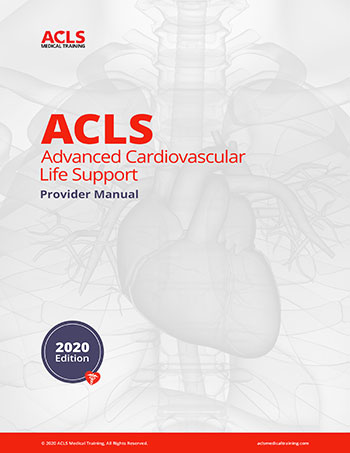At ACLS Medical Training, we strive to have the highest quality ACLS certification curriculum.
How to Use Our ALCS Study Materials
The Experienced Provider
If you are an experienced ACLS provider who is simply looking for a straightforward, convenient way to renew your certification, ACLS Medical Training recommends starting with the latest ACLS guideline changes. Near the beginning of the ACLS provider manual you will find a table that lists all of the key guideline changes made to the ACLS manual in the most recent edition. Then you should look over the ACLS algorithms.
The First Time Student
If this is your first ACLS certification, we recommend going through the ACLS provider manual carefully and systematically. Read each section carefully and commit the algorithms to memory. If you want to see how you are progressing, take the ACLS practice test before you take the full examination. Once you are confident, we strongly recommend that you practice with megacodes. These scenarios require you to apply the ACLS algorithms on a “patient” who may change status and condition during the “code.” It is a good test of your ACLS knowledge and mimics what takes place during the ACLS skills test.
A Provider with a Lapsed Certification
If it has been more than two years since your last ACLS certification, you will want to start with the most recent ACLS guideline changes in our ACLS provider manual. This will catch you up with the current recommendations. We suggest that you test your memory by working through one of the megacodes. If you can confidently manage the “patient,” you may be ready to take the ACLS recertification examination. If you find that you have forgotten the material, you may want to spend some time with the ACLS provider manual and re-learn the material you may have forgotten.
The ACLS Study Guide includes:
- ACLS Overview
- Preparing for ACLS
- Organization of the ACLS Course
- ACLS Guideline Changes
- BLS and ACLS Surveys
- BLS Survey
- Adult BLS/CPR
- ACLS Survey
- Team Dynamics
- Systems of Care
- Post-Cardiac Arrest Care
- Acute Coronary Syndromes (ACS)
- Acute Stroke Care
- Education and Teams
- ACLS Cases
- BLS and ACLS Surveys
- Respiratory Arrest
- Basic Airway Management
- Oropharyngeal Airway
- Nasopharyngeal Airway
- Advanced Airway Management
- Suctioning the Airway
- Ventricular Fibrillation, Pulseless Ventricular Tachycardia, PEA and Asystole
- Cardiac Arrest: Ventricular Fibrillation (VF) with CPR and AED
- Adult BLS/CPR
- Using the Automated External Defibrillator
- Cardiac Arrest Case
- Manual Defibrillation for VF or Pulseless VT
- Routes of Access for Medication Administration
- Insertion of an IO Catheter
- Monitoring During CPR
- Medications Used during Cardiac Arrest
- When to Terminate Resuscitation Efforts
- Post-Cardiac Arrest Care
- Acute Coronary Syndrome (ACS)
- ACS Algorithm
- Bradycardia
- Stable and Unstable Tachycardia
- Tachycardia Algorithm
- Opioid Overdose Algorithm
- Acute Stroke
- Suspected Stroke Algorithm
- Commonly Used Medications in Resuscitation
- Rhythm Recognition
- Sinus Rhythm
- Sinus Bradycardia
- Sinus Tachycardia
- Sinus Rhythm with 1st Degree Heart Block
- 2nd Degree AV Heart Block
- 3rd Degree Heart Block
- Supraventricular Tachycardia (SVT)
- Atrial Fibrillation (AF)
- Atrial Flutter
- Asystole
- Pulseless Electrical Activity
- Ventricular Tachycardia (VT)
- Ventricular Fibrillation (VF)
